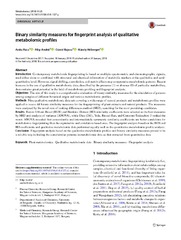Приказ основних података о документу
Binary similarity measures for fingerprint analysis of qualitative metabolomic profiles
| dc.creator | Racz, Anita | |
| dc.creator | Andrić, Filip | |
| dc.creator | Bajusz, David | |
| dc.creator | Héberger, Karoly | |
| dc.date.accessioned | 2018-11-22T00:43:28Z | |
| dc.date.available | 2018-11-22T00:43:28Z | |
| dc.date.issued | 2018 | |
| dc.identifier.issn | 1573-3882 | |
| dc.identifier.uri | https://cherry.chem.bg.ac.rs/handle/123456789/2101 | |
| dc.description.abstract | Introduction Contemporary metabolomic fingerprinting is based on multiple spectrometric and chromatographic signals, used either alone or combined with structural and chemical information of metabolic markers at the qualitative and semiquantitative level. However, signal shifting, convolution, and matrix effects may compromise metabolomic patterns. Recent increase in the use of qualitative metabolomic data, described by the presence (1) or absence (0) of particular metabolites, demonstrates great potential in the field of metabolomic profiling and fingerprint analysis. Objectives The aim of this study is a comprehensive evaluation of binary similarity measures for the elucidation of patterns among samples of different botanical origin and various metabolomic profiles. Methods Nine qualitative metabolomic data sets covering a wide range of natural products and metabolomic profiles were applied to assess 44 binary similarity measures for the fingerprinting of plant extracts and natural products. The measures were analyzed by the novel sum of ranking differences method (SRD), searching for the most promising candidates. Results Baroni-Urbani-Buser (BUB) and Hawkins-Dotson (HD) similarity coefficients were selected as the best measures by SRD and analysis of variance (ANOVA), while Dice (Di1), Yule, Russel-Rao, and Consonni-Todeschini 3 ranked the worst. ANOVA revealed that concordantly and intermediately symmetric similarity coefficients are better candidates for metabolomic fingerprinting than the asymmetric and correlation based ones. The fingerprint analysis based on the BUB and HD coefficients and qualitative metabolomic data performed equally well as the quantitative metabolomic profile analysis. Conclusion Fingerprint analysis based on the qualitative metabolomic profiles and binary similarity measures proved to be a reliable way in finding the same/similar patterns in metabolomic data as that extracted from quantitative data. | en |
| dc.publisher | Springer, New York | |
| dc.relation | info:eu-repo/grantAgreement/MESTD/Basic Research (BR or ON)/172017/RS// | |
| dc.relation | Serbian Academy of Sciences and Arts [HF-2016, NKM-74/2017] | |
| dc.relation | National Research, Development and Innovation Office of Hungary [K 119269, KH_17 125608] | |
| dc.relation | Hungarian Academy of Sciences | |
| dc.rights | openAccess | |
| dc.rights.uri | https://creativecommons.org/licenses/by/4.0/ | |
| dc.source | Metabolomics | |
| dc.subject | Plant metabolomics | en |
| dc.subject | Qualitative metabolomic data | en |
| dc.subject | Binary similarity measures | en |
| dc.subject | Fingerprint analysis | en |
| dc.title | Binary similarity measures for fingerprint analysis of qualitative metabolomic profiles | en |
| dc.type | article | |
| dc.rights.license | BY | |
| dcterms.abstract | Рацз, Aнита; Хебергер, Каролy; Бајусз, Давид; Aндрић, Филип; | |
| dc.citation.volume | 14 | |
| dc.citation.issue | 3 | |
| dc.identifier.wos | 000426529500012 | |
| dc.identifier.doi | 10.1007/s11306-018-1327-y | |
| dc.citation.other | 14(3): 29 | |
| dc.citation.rank | M22 | |
| dc.identifier.pmid | 29568246 | |
| dc.description.other | Supplementary material: [http://cherry.chem.bg.ac.rs/handle/123456789/3041] | |
| dc.type.version | publishedVersion | |
| dc.identifier.scopus | 2-s2.0-85041598318 | |
| dc.identifier.fulltext | https://cherry.chem.bg.ac.rs/bitstream/id/9118/2099.pdf |


